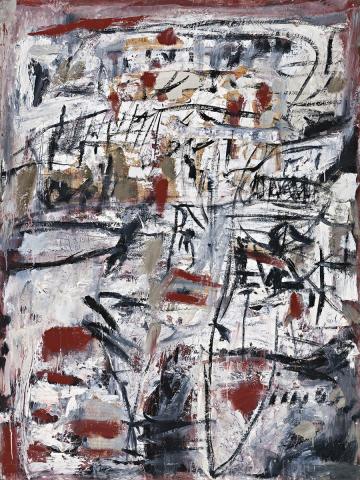RED COLLAGE, c.1960
TONY TUCKSON
oil, collage and synthetic polymer paint on composition board
122.0 x 91.5 cm
Watters Gallery, Sydney
The Estate of the late James O. Fairfax AC, New South Wales, acquired from the above in 1970
Tony Tuckson Stock Exhibition, Watters Gallery, Sydney, 19 August – 7 September 1970, cat. 17
Painting Forever: Tony Tuckson, National Gallery of Australia, Canberra, 4 November 2000 – 4 February 2001; Art Gallery of South Australia, Adelaide, 23 March – 20 May 2001; Ballarat Fine Art Gallery, Ballarat, 7 September – 21 October 2001; Hazelhurst Regional Gallery and Arts Centre, Sydney, 15 December 2001 – 10 February 2002; Heide Museum of Modern Art, Melbourne, 23 February – 21 April 2002, cat. 29
Thomas, D., Free, R. and Legge, G., Tony Tuckson, Craftsman House, Sydney, 1989, pl. 71, pp. 78 (illus.), 181
Maloon, T., and Fisher, T., Painting Forever: Tony Tuckson, National Gallery of Australia, Canberra, 2000, pp. 28 (illus.), 61
Red Collage, c.1960 was included in the 1970 exhibition of Tony Tuckson’s work at Watters Gallery, Sydney, his first solo exhibition – and one of only two held during his lifetime – that included a selection of 65 paintings made since the late 1950s. Although he described himself as a ‘Sunday painter’ who only made art in his spare time, Tuckson painted throughout much of his life and was a prolific draughtsman. His reluctance to exhibit his work publicly and even to show it to more than a handful of intimates, was due to his role at the Art Gallery of New South Wales, where from 1950 until his death in 1973 he was assistant and then deputy director, and the conflict he perceived between his professional responsibilities and his art practice.
Tuckson’s distinctive visual language emerged from various sources. An academic art education in London was followed by post-war studies at the East Sydney Technical College that included what he described as his most influential lessons with pioneering abstract artists Grace Crowley and Ralph Balson. His work at the Art Gallery of New South Wales also brought Tuckson into direct contact with an extraordinary range of art, from the gallery’s collection and international travelling exhibitions, to contemporary art encountered during visits to artists’ studios and commercial exhibitions that he made in his professional capacity. Tuckson established the gallery’s collections of Aboriginal and Melanesian art and his deep knowledge of the Indigenous art of Australia was another influence that according to his wife Margaret, ‘first interested him for its casual way of filling an area, the lack of worry about shapes spilling over outlines.’1
Painted around 1960, Red Collage was made at the time that Tuckson was leaving figuration behind and moving confidently and decisively into pure abstraction. A richly textured field of grey, black and white paint, with highlights of burgundy and the darkened brown of collaged newspaper breaking up the painted surface, is overlaid with an energetic tracery of black lines. These calligraphic marks are a distinctive feature of Tuckson’s work of the period and reflect both the energy and physicality with which he painted. As a student, Tuckson stated that ‘when you start worrying about the position of a mark, you cease to paint’,2 and the free, intuitive nature of his mark-making is a distinctive and satisfying element that runs throughout his oeuvre.
Following a second solo exhibition in 1973 Sandra McGrath wrote in Art and Australia that ‘Tuckson was recognised almost overnight for what he was – the best Action Painter in Australia and one of the country’s most important artists’.3 In the years since, a series of important exhibitions, the publication of a major monograph and the collecting of his art by public galleries and private individuals alike has confirmed the quality, individuality and beauty of Tuckson’s work and its significance as the most authentic example of abstract expressionism to emerge in Australia.
1. Thomas, D., Free, R., Legge, G., Tony Tuckson, Craftsman House, Sydney, 1989, p. 39
2. McGrath, S., ‘Tony Tuckson’, Art and Australia, Ure Smith, Sydney, vol. 12, no. 2, 1974, p. 156
3. ibid., p. 166
KIRSTY GRANT
Former Director of Heide Museum of Modern Art
Former Senior Curator, National Gallery of Victoria
